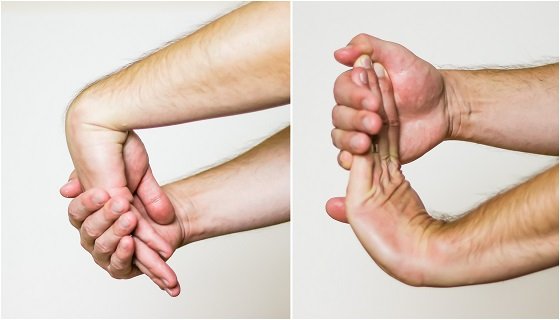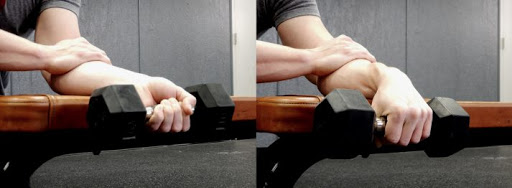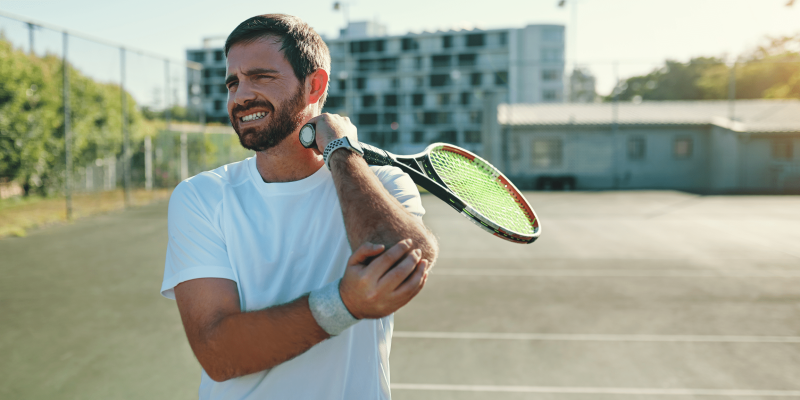Tennis elbow, also known as lateral epicondylitis, is one of the most common painful conditions of the elbow. Inflammation and pain occur on and around the outer bony bump of the elbow where the muscles and tendons attach to the bone. These structures are responsible for lifting your wrist up so this condition can occur with many activities, not just tennis.
On the other hand, Medial epicondylitis, also called golfer’s elbow, is tendinopathy of the medial common flexor tendon of the elbow due to overload or overuse. It may also be referred to as pitcher’s elbow, or termed tendinosis or epicondylalgia instead of epicondylitis (Read more).
What is Tendinopathy?
Tendinopathy occurs when a tendon is unable to adapt to the strain being placed upon it. This leads to repeated small amounts of damage within the tendon fibers and results in the tendon trying to heal itself in response to the strain. Medial epycondilitis occurs often in repetitive upper extremity activities such as computer use, heavy lifting, forceful forearm pronation and supination, and repetitive vibration.
Why does it hurt?
It hurts because you are putting tension on a place where the tissue is weakened, which is usually due to a degenerative process that seems to take a long time for your body to recognize and heal. Chronic Tennis Elbow is associated with degenerative changes in the muscle tissues located at the epicondyle. Although for a long time this was thought to be related to inflammation from overuse, this is now known to be incorrect.
Why do I have it?
This is a common problem and unfortunately, we don’t know why some people get this condition and others do not. Surprisingly, it is not at all clear that it comes from overuse or something that you did “wrong”. There is no doubt that if you do have tennis elbow, it will bother you more to do certain things, but that does not necessarily mean it was caused by those activities.
Pain is not always a bad thing?
Before I show you a sample of a rehabilitation plan, you need to understand whether should you avoid any activities that make your elbow sore? The answer is simply no.
To help you measure your pain you can simply use the pain scale below. Any activities that make you elbow sore more than 4 – 5 out of 10 can be minimized on a daily bases.

The following are some exercises that aid with pain relief and improve your movement. These exercises should be performed daily, however we would suggest you being evaluated by a physiotherapist before for correct diagnosis.
Rehabilitation plan
1- In the acute phase, you can follow the POLICE protocol and avoid any HARM. In severe cases, your physician may also prescribe some anti-inflammatory medication to take for a couple of weeks. Before you start any of the exercises below your pain and symptoms has to be settle down and by then you can introduce these exercises daily.
2- Identify and modify your daily activities that aggravate your (elbow pain) and minimize the repetitive overload. (Based on the Pain scale).
3- Wearing a tennis elbow barace at night may also help take the pressure off of the tendons where they attach to the bone (It is not recommended to use it in a long run). This can be worn only during any type of wrist/elbow activity as well if you find those activities aggravate your pain.
4- Sleeping position, especially if you find always waking up with a sore elbow in the morning you need to watch your sleeping position and cushioned your elbow. For instance, add a pillow under your arm.
5- Stretching and strengthening the muscles and tendons involved are key to making this problem go away.
Wrist stretches
Bend your wrist forward and hold with the other hand for 15 sec for 3 sets – try the same stretch backward and stretch the wrist flexor hold for 15 sec 3 sets.

Strengthening Exercises (Dumbbell wrist extension/wrist flexion)
Sit in a chair with your forearm resting on a table. Hang your wrist and hand over the edge of the table. Hold a one or two-pound dumbbell in your hand with your palm facing down, and slowly lift your hand so the back of your hand moves towards the ceiling. Your forearm should remain on the table.
Once your wrist is fully extended, hold the end position for a second, then slowly lower your hand down. Repeat this motion for 10 to 15 repetitions, and perform to three sets.
(While doing this exercise in regard to pain scale it shouldn’t be more than 3 -4 out of 10)

After performing wrist extension, continuing resting your forearm on the table, and turn your hand over so your palm is facing the ceiling.
While keeping your forearm against the table, flex your wrist up so that your palm moves towards the ceiling. Once your wrist is fully flexed, hold the position for a second. Then, slowly lower hand back to the starting position. Repeat the wrist flexion exercise for three sets of 10-15 repetitions.
(While doing this exercise in regard to pain scale it shouldn’t be more than 3 -4 out of 10)
Forearm pronation and supination strengthening:
Hold a one or two-pound dumbbell (or a hammer) in your hand and bend your elbow 90° on the edge of the table. Slowly rotate your hand with your palm upward (supination) for 3 sets of 10 repetitions and then repeat the same rotation with the palm downward (pronation) for 3 sets of 10 repetitions.
(While doing this exercise in regard to pain scale it shouldn’t be more than 3 -4 out of 10)

Next step
Want to get in touch with our team of a therapist or you are looking for some advice? Simply fill in your details below & we get in touch with you shortly.
FOLLOW US ON YOUTUBE AND GET ACCESS TO OUR WEEKLY FREE REHABILITATION EXERCISES.
Our Approach
Dublin Sports Injury Clinic is a physical therapy clinic based in Pearse Street, Dublin 2. We have a holistic approach to our assessment and treatment. The initial assessment helps us to explore your risk factors and help you to get pain free shortly and stop any further injuries. We will design a customized training program for you to start with, and we will coach you and monitor your progress closely. We prescribe relative rest or modified activities as required. Depending on the individual requirement, we apply manual therapy accompanied by stretching to restore tissue elasticity and reduce the strain in the muscle-tendon unit with joint motion.
Disclaimer: This article is for information only and should not be used for the diagnosis or treatment of medical conditions. You can contact us if you would like to book an appointment or get some advice from our therapist.

